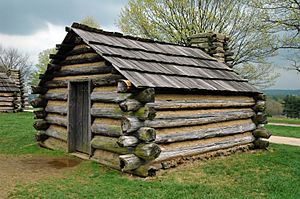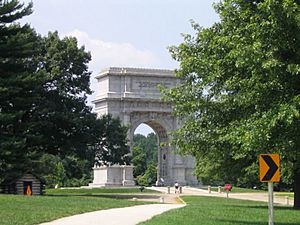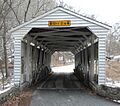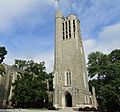Valley Forge National Historical Park facts for kids
|
Valley Forge National Historical Park
|
|
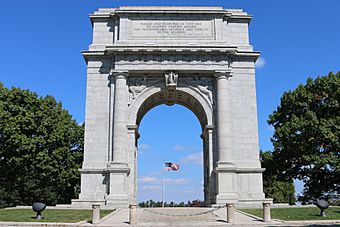
The National Memorial Arch at the park
|
|
| Location | Montgomery County and Chester County, Pennsylvania |
|---|---|
| Nearest city | King of Prussia, Pennsylvania |
| Area | 3,466 acres (1,403 ha) |
| Visitation | 1,645,298 (2022) |
| Website | Valley Forge National Historical Park |
| NRHP reference No. | 66000657 |
Quick facts for kids Significant dates |
|
| Added to NRHP | October 15, 1966 |
| Designated NHLD | January 20, 1961 |
| Designated NHP | State Park: 1893 National Historical Park: July 4, 1976 |
Valley Forge National Historical Park is a special place where a very important part of American history happened. It's where George Washington and his Continental Army spent a tough winter during the American Revolutionary War. This park helps us remember their struggles and how they became a stronger army.
Today, the park covers about 3,500 acres (1,400 ha) of land. Almost 2 million people visit it every year! You can see old buildings, rebuilt soldier cabins, and monuments. There's also a museum with real items from the past. Plus, the park has over 30 miles (48 km) of trails for hiking and biking.
Contents
A Winter of Hardship and Hope
From December 19, 1777, to June 19, 1778, about 12,000 American soldiers camped at Valley Forge. These soldiers were part of the Continental Army, led by General George Washington. They were fighting for America's freedom from Great Britain in the American Revolutionary War.
Washington chose Valley Forge because it was a good spot. It was between the British Army in Philadelphia and the American government in York. It was also close to places where the army could get supplies. At the same time, it was far enough from Philadelphia to be safe from a surprise attack.
This winter was one of the hardest times for the Continental Army. Soldiers faced freezing cold, hunger, and sickness. But they also used this time to get stronger. A skilled soldier named Baron Friedrich von Steuben helped train them. This training made the army much better and helped them win the war. It was a turning point that led to the creation of the United States.
How Valley Forge Became a Park
People wanted to save Valley Forge's history. In 1878, a group called the Centennial and Memorial Association of Valley Forge started working to protect Washington's Headquarters. They also wanted to save the land around it.
In 1893, Valley Forge became the first state park in Pennsylvania. The goal was to keep the site where Washington's army camped safe and open to the public. The park grew over the years. In 1961, it was named a U.S. National Historic Landmark. This means it's a place with special historical importance.
Then, in 1976, Pennsylvania gave the park to the nation as a gift. This happened during America's 200th birthday celebration. President Gerald Ford signed a law making Valley Forge the 283rd unit of the National Park System. This made sure the park would be protected and shared with everyone.
What You Can See and Do
Washington's Headquarters
One of the most popular places to visit is the house where General George Washington lived. This old colonial home has been restored to look like it did during the encampment. You can also see the quarters (living areas) of other important generals like Marquis de Lafayette and Henry Knox. The old train station nearby has also been restored and now serves as an information center.
Rebuilt Cabins and Defenses
All around the park, you can see rebuilt log cabins. These show what the soldiers' homes looked like during that harsh winter. You can also see earthworks, which are dirt walls and ditches the soldiers built to defend their camp. These include four redoubts (small forts) and a reconstructed abatis (a barrier made of sharpened tree branches).
Washington Memorial Chapel
The Washington Memorial Chapel is a beautiful church located on a hill in the park. It was built to honor George Washington. Next to it is the National Patriots Bell Tower, which has bells that play music. The chapel is still a working church today.
Memorials and Monuments
The National Memorial Arch is a huge monument at the southern end of the park. It honors all the soldiers who camped at Valley Forge. It was finished in 1917. The arch has a famous quote from George Washington about his army's strength and patience.
As you drive through the park, you'll see large stones honoring each of the army's brigades. There's also a statue of General Anthony Wayne on a horse.
Hiking and Biking Trails

The park has more than 30 miles (48 km) of trails for hiking, biking, and even horseback riding. The main trail is the Joseph Plumb Martin Trail, which is a 5-mile (8 km) loop around the park. Other trails, like the Schuylkill River Trail, also pass through Valley Forge.
The Valley Forge Train Station
Near Washington's Headquarters is the historic Valley Forge Train Station. It was built in 1911 and was how many visitors arrived at the park by train from Philadelphia. The station was restored in 2009. Now, it's a museum and information center that helps visitors learn more about Washington's Headquarters and the village of Valley Forge.
Protecting the Park Today
Over the years, there have been efforts to protect the land around Valley Forge. For example, in 2002, a company bought some land within the park's boundaries. But the National Park Service later bought it back to keep it safe.
Another challenge for the park is too many white-tailed deer. A large deer population can change the types of plants that grow in the park. The National Park Service is working on a plan to manage the deer and protect the park's natural environment.
Images for kids
See also
- Freedoms Foundation at Valley Forge
- Kennedy Mansion (Valley Forge)
- List of National Historic Landmarks in Pennsylvania
External links
- "Determined to Persevere: The Valley Forge Encampment"
pt:Vale Forge






